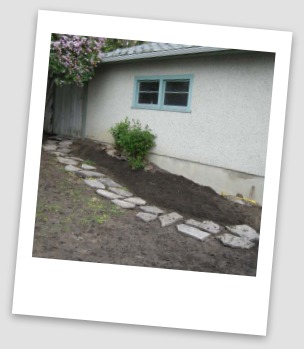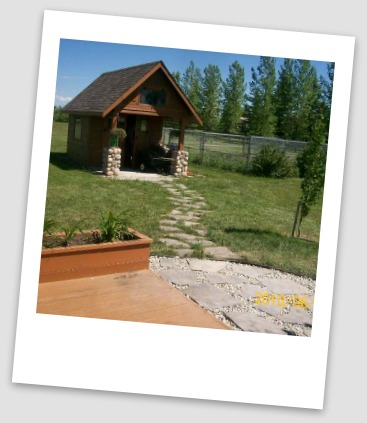E. Laying Stepping Stones
Laying stepping stones will be broken down into two sections. The first section: for those of you making your stepping stone pathways in the grass. The second section: for those of you making your stepping stone pathway in a excavated bed of any other materials.
These projects are relatively easy for homeowners, but we do have a few Landscaping tips to save you time and money.
For both projects when you are laying your stones, make sure that you try walking along your path before you begin setting stones in the ground.
You want to make sure the spacing is right for the average person. (We don't all have the same stride.)
It is much better moving stones and making adjustments before you set them or cut out the grass. Play around with them until you are happy with the way the stepping stone path looks, and the stride before you do any digging.
Stepping stone pathway through grass.
Tip: If your are laying a stepping stone pathway in new sod, play with the shape and placement before the new sod is laid down (see picture below). This avoids excessive trampling and damaging of the new sod.
When you are happy with the way you have your stones placed, the next thing you are going to do is cut out around the stone with a shovel. I prefer to use a small square shovel for this.

Cut as close as you can to the edges, so when you remove the grass and dirt the stone fits into the hole fairly tight. Remember to dig down a couple of inches deeper than the thickness of the stone to allow for a sand base for setting the stone.
Your goal here is to have the top of the stone set at the same level as where the grass meets the soil. This makes it easier to mow over without damaging your mower blade or cause a tripping hazard.
Next, you are going to be putting down a couple of inches of sand or crushed rock under the stone to settle it. Drop the stone back in the hole and twist it from side to side as much as you can.
You can also take your rubber mallet and give it a few hits to settle it as well. Be careful not to hit it too hard or you may crack the stone. This is why I use 2 to 3 inch stones for a stepping path.
If the stone was relatively flat it should settle fairly easily. However, if there are any small contours in the stone it may require some adjusting. Pick up the stone without disturbing the sand or gravel underneath so you can see the impression the stone left. Now you can see where you are either going to add or take away sand or gravel, to make it level.
This can be a slow process and take more than one try. Be patient and don't get frustrated if you don't get it right away. When you have stabilized the stone try walking on it and rocking it. If it is still moving, go back to adding and removing sand until it has no movement before moving on to the next stone. Continue this process until you have completed the whole path.
Once your path is set and you are happy with it, go back and fill in all the gaps around the edge of the stone with dirt. This will allow the grass to migrate into the soil and make the gap disappear much quicker.
You are now done, it's that simple.
Stepping stone pathways in other materials.
This is a little different than a stepping stone path through a lawn. You should still place all your stepping stones where you want them before you start any work.
I usually lay them on the landscaping fabric after I have the area excavated. You have the option of building the walkway now or filling in the area and setting the stones after.

If you want the walkway in first, build a base for each stone with washed clean sand and gravel and set your pathway stones almost like building a small series of islands.
Setting the stones after the area is filled in is pretty straight forward as well. The problem you may run into is setting the stones in certain types of rocks. you may want to put a smaller crushed stone or sand down first to make it easier to settle the stones.
Setting stones means twisting from side to side or sliding back and forth. The larger the size of rock, the more difficult this can be.
Make sure the height of the stone is equal to the ground on each side of the path. Place a long board across the excavation as a guide if you have to. You can also use your rubber mallet and give it a few hits to settle it as well. (Be careful not to hit it too hard or you may crack the stone.)
If the stone was relatively flat it will settle fairly easily. Small contours in the stone make it more challenging. This is why we recommend for beginners to buy the flattest stone they can.
If you can pick up the stone without disturbing the base underneath, you can see the impression the stone left. This will show you where you are either going to have to add, or take away material to make it level.
This can be a slow process and take more than one try. Be patient and don't get frustrated if you don't get it right away.
When you have stabilized the stone try walking on it and rocking it back and forth to test your work. If it is still moving, go back to adding and removing sand or gravel to make it more stable. If is has no movement, move on to the next stone.
Continue this process until you have stabilized all the stones in the path. Use your filler material as you go because this will also help stabilize the stones.
I would recommend using gravel or decorative rock as a material to border the stones. Mulch or other organic materials can be used, but lack the same ability in stabilizing the stepping stones.
You are now finished. Give the stones a good wash to get the dust off them and show their true colors. The final task is Completion of your Stepping Stone Path.
_____________________________________
Table of Contents: Stepping Stone Path
Introduction: Stepping Stone Path
C. Stepping Stone Path Materials
D. Stepping Stone Path Site Preparation
F. Stepping Stone Path Completion
______________________________________
Go to "The Yard: Landscaping How-to Modules"
Go to Dream Yard Home Page from Laying Stepping Stones
Check out our time and money saving e-book
How to avoid the biggest mistakes made by DIYers, designers, and landscaping companies.
Visitor
Favorites
Giggles 'n' Thoughts





